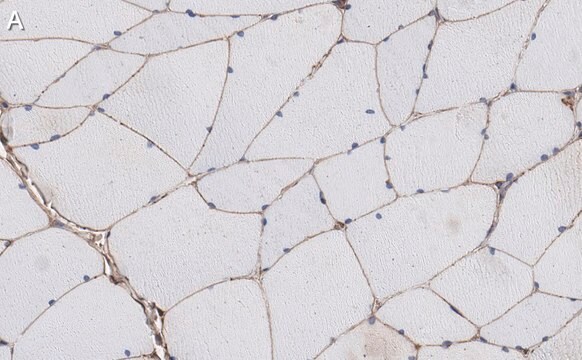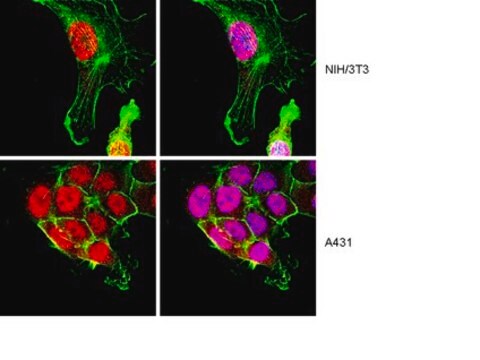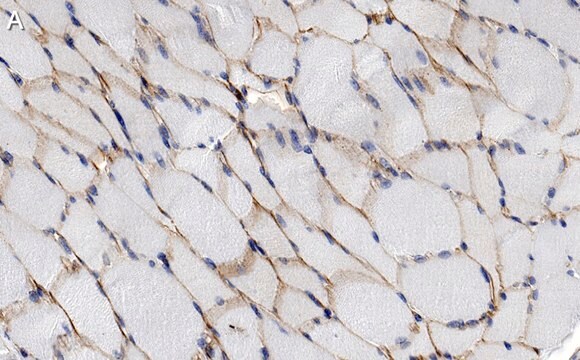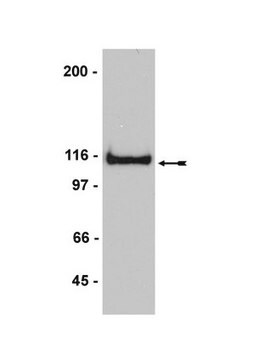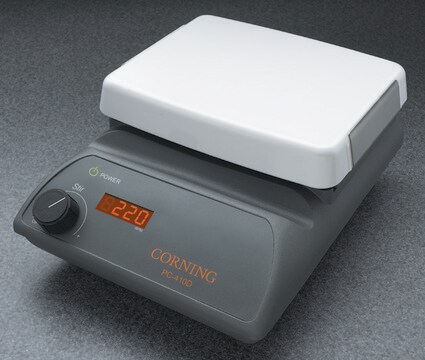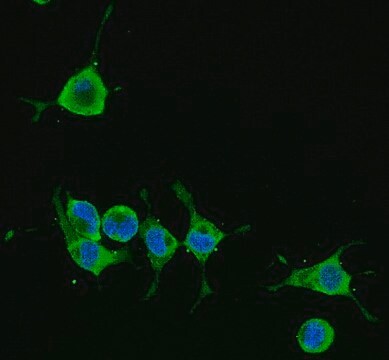05-593
Anti-α-Dystroglycan Antibody, clone IIH6C4
ascites fluid, clone IIH6C4, Upstate®
동의어(들):
Dystrophin-associated glycoprotein 1, dystroglycan 1, dystroglycan 1 (dystrophin-associated glycoprotein 1), dystrophin-associated glycoprotein-1, LARGE-glycan, Large glycan
로그인조직 및 계약 가격 보기
모든 사진(4)
About This Item
UNSPSC 코드:
12352203
eCl@ss:
32160702
NACRES:
NA.41
추천 제품
생물학적 소스
mouse
항체 형태
ascites fluid
클론
IIH6C4, monoclonal
종 반응성
human, mouse, canine, rat, guinea pig, rabbit
제조업체/상표
Upstate®
기술
immunofluorescence: suitable
immunohistochemistry: suitable
inhibition assay: suitable
western blot: suitable
동형
IgM
NCBI 수납 번호
UniProt 수납 번호
배송 상태
dry ice
타겟 번역 후 변형
unmodified
유전자 정보
human ... DAG1(1605)
일반 설명
Dystroglycans are essential elements of the neuromuscular junction (NMJ). The gene for dystroglycan is expressed as a precursor protein that is post translationally cleaved into a 156 kDa extracellular peripheral membrane protein called alpha dystroglycan and a 43 kDa transmembrane protein, beta dystroglycan. The latter protein contains a PPxY motif that promotes binding to WW domain containing proteins, such as utrophin and dystrophin. Phosphorylation at tyrosine 892 within the PPxY motif may regulate c Src interactions with beta dystroglycan, as well as inhibit interactions with WW domain proteins. In skeletal muscle, beta dystroglycan is normally localized to the plasma membrane, however phosphorylation of Tyr892 leads to localization of beta dystroglycan to endosomal compartments along with c Src. Thus, phosphorylation at Tyr892 may have important roles in altering the localization of beta dystroglycan during NMJ formation.
This product may be used for research purposes only. Diagnostic use of this product requires a license from the University of Iowa Research Foundation, 214 Technology Innovation Center, Iowa City, IA 52242
특이성
This antibody recognizes α-Dystroglycan/LARGE-glycan, Mr 156 kDa.
면역원
Rabbit skeletal muscle membrane preparation. Clone IIH6C4.
애플리케이션
Inhibition of Laminin Binding to Dystroglycan: An independent lab has shown, in a nitrocellulose overlay experiment, that this antibody inhibits binding of 125I-laminin to dystroglycan (Ervasti, J., et al. (1993).
Western Blot Analysis: A previous lot of this antibody was used on mouse muscle tissue lysate 3 months after shRNA induction, and in littermate controls (ctrl) and LARGE-null negative control (myd) (Goddeeris, M., et al. 2013, Nature).
Immunofluorescence: A previous lot of this antibody was used to detect α-Dystroglycan /LARGE-glycan in mouse muscle tissue (Goddeeris, M., et al. 2013, Nature).
Western Blot Analysis: A previous lot of this antibody was used on mouse muscle tissue lysate 3 months after shRNA induction, and in littermate controls (ctrl) and LARGE-null negative control (myd) (Goddeeris, M., et al. 2013, Nature).
Immunofluorescence: A previous lot of this antibody was used to detect α-Dystroglycan /LARGE-glycan in mouse muscle tissue (Goddeeris, M., et al. 2013, Nature).
Research Category
Metabolism
Metabolism
Research Sub Category
Muscle Physiology
Muscle Physiology
This Anti-α-Dystroglycan Antibody, clone IIH6C4 is validated for use in IH, FUNC, WB for the detection of α-Dystroglycan.
품질
Routinely evaluated by western blot on rabbit skeletal muscle.
Western Blot Analysis:
A 1:1000-1:2000 dilution of this lot detected α-Dystroglycan/LARGE-glycan in rabbit skeletal muscle.
Note: The use of WGA purified protein results in significantly cleaner blots and immunoprecipitates.
Post-translational modification of dystroglycan causes band broadening.
Western Blot Analysis:
A 1:1000-1:2000 dilution of this lot detected α-Dystroglycan/LARGE-glycan in rabbit skeletal muscle.
Note: The use of WGA purified protein results in significantly cleaner blots and immunoprecipitates.
Post-translational modification of dystroglycan causes band broadening.
표적 설명
156 kDa
물리적 형태
Mouse ascites, in PBS containing 0.05% sodium azide and 30% glycerol.
Liquid at -20ºC.
Liquid at -20ºC.
Unpurified
저장 및 안정성
Stable for 1 year at -20°C from date of receipt. For maximum recovery of product, centrifuge the vial prior to removing the cap.
분석 메모
Control
Rabbit skeletal muscle lysate.
Rabbit skeletal muscle lysate.
기타 정보
Concentration: Please refer to the Certificate of Analysis for the lot-specific concentration.
법적 정보
UPSTATE is a registered trademark of Merck KGaA, Darmstadt, Germany
면책조항
Unless otherwise stated in our catalog or other company documentation accompanying the product(s), our products are intended for research use only and are not to be used for any other purpose, which includes but is not limited to, unauthorized commercial uses, in vitro diagnostic uses, ex vivo or in vivo therapeutic uses or any type of consumption or application to humans or animals.
Storage Class Code
12 - Non Combustible Liquids
WGK
WGK 2
Flash Point (°F)
Not applicable
Flash Point (°C)
Not applicable
시험 성적서(COA)
제품의 로트/배치 번호를 입력하여 시험 성적서(COA)을 검색하십시오. 로트 및 배치 번호는 제품 라벨에 있는 ‘로트’ 또는 ‘배치’라는 용어 뒤에서 찾을 수 있습니다.
Mice Lacking Dystrophin or {alpha} Sarcoglycan Spontaneously Develop Embryonal Rhabdomyosarcoma with Cancer-Associated p53 Mutations and Alternatively Spliced or Mutant Mdm2 Transcripts.
Fernandez K, Serinagaoglu Y, Hammond S, Martin LT, Martin PT
The American Journal of Pathology null
A role for the dystrophin-glycoprotein complex as a transmembrane linker between laminin and actin.
Ervasti, J M and Campbell, K P
The Journal of cell biology, 122, 809-823 (1993)
Susan Sparks et al.
BMC neurology, 7, 3-3 (2007-01-31)
Hereditary Inclusion Body Myopathy (HIBM) is an autosomal recessive, adult onset, non-inflammatory neuromuscular disorder with no effective treatment. The causative gene, GNE, codes for UDP-N-acetylglucosamine 2-epimerase/N-acetylmannosamine kinase, which catalyzes the first two reactions in the synthesis of sialic acid. Reduced
Francesca Sciandra et al.
BMC research notes, 10(1), 601-601 (2017-11-22)
Dystroglycan (DG) is an adhesion complex formed by two subunits, α-DG and β-DG. In skeletal muscle, DG is part of the dystrophin-glycoprotein complex that is crucial for sarcolemma stability and it is involved in a plethora of muscular dystrophy phenotypes.
B Wu et al.
Gene therapy, 21(9), 785-793 (2014-06-20)
Antisense therapy with both chemistries of phosphorodiamidate morpholino oligomers (PMOs) and 2'-O-methyl phosphorothioate has demonstrated the capability to induce dystrophin expression in Duchenne muscular dystrophy (DMD) patients in phase II-III clinical trials with benefit in muscle functions. However, potential of
자사의 과학자팀은 생명 과학, 재료 과학, 화학 합성, 크로마토그래피, 분석 및 기타 많은 영역을 포함한 모든 과학 분야에 경험이 있습니다..
고객지원팀으로 연락바랍니다.